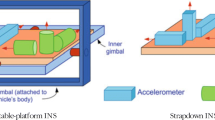Abstract
In this work, several classical ideas concerning the geometry of the inertia of a rigid body are revisited. This is done using a modern approach to screw theory. A screw, or more precisely a twist, is viewed as an element of the Lie algebra to the group of proper rigid-body displacements. Various moments of inertia, about lines, planes and points are considered as geometrical objects resulting from least-squares problems. This allows relations between the various inertias to be found quite simply. A brief review of classical line geometry is given; this includes an outline of the theory of the linear line complex and a brief introduction to quadratic line complexes. These are related to the geometry of the inertia of an arbitrary rigid body. Several classical problems concerning the mechanics of rigid bodies subject to impulsive wrenches are reviewed. We are able to correct a small error in Ball’s seminal treatise. The notion of spatial percussion axes is introduced, and these are used to solve a problem concerning the diagonalisation of the mass matrix of a two-joint robot.
Similar content being viewed by others
References
Ball R.S.: Researches in the dynamics of a rigid body by the aid of the theory of screws. Philos. Trans. R. Soc. Lond. 164, 15–40 (1874)
Ball R.S.: A Treatise on the Theory of Screws. Cambridge University Press, Cambridge (1900)
Bottema O., Roth B.: Theoretical Kinematics. Dover Publications, New York (1990)
Bruchheim A.: A memoir on biquaternions. Am. J. Math. 7, 293–326 (1885)
Demoulin A.: Sur le complexe des droites par lesquelles on peut mener à une quadrique deux planes tangents rectangulaires. Bulletin de la Société Mathematique de France 20, 122–132 (1892)
Fouret, G.: Notions Géométriques sur les Complexes et les Congruence de Droites. In: Schoenflies, A.M. Appendix to Géométrie de Mouvement, Gauthier-Villars et fils, Paris (1893)
Gibson C.G., Hunt K.H.: Geometry of Screw Systems I & II. Mech. Mach. Theory 25, 1–27 (1990)
Hilbert, D., Cohn-Vossen, S.:Geometry and the Imagination, vol 87. AMS Chelsea Publishing Series, American Mathematical Society (1999)
Hudson R.W.H.T.: Kummer’s Quartic Surface. Cambridge University Press, Cambridge (1905)
Ivory, J.: On the Attractions of Homogeneous Ellipsoids. Philos. Trans. R. Soc. Lond., 345–372 (1809)
Jessop C.M.: A Treatise on the Line Complex. Cambridge University Press, Cambridge (1903)
Laub A.J.: Matrix Analysis for Scientists and Engineers. SIAM, Philadelphia, PA (2004)
Painvin, L.F.: Ètude d’un complexe du second ordre. Nouvelles Annales de Mathématiques, 2e série, tome 11, pp. 49–60, pp. 97–107, pp. 202–210, pp. 481–500, pp. 529–539, (1872)
Rees E.L.: Line complexes in kinematics. Am. Math. Mon. 35, 296–299 (1928)
Salmon G.: A Treatise on the Analytical Geometry of Three Dimensions. Hodges & Figis, Dublin (1882)
Selig J.M.: Geometric Fundamentals of Robotics. Springer, New York (2005)
Selig, J.M.: The Complex of Lines from Successive Points and the Horopter. In: IEEE international conference on robotics and automation, pp. 2380–2385. Pasadena, CA (2008)
Semple J.G., Kneebone G.T.: Algebraic Projective Geometry. Clarendon Press, Oxford (1952)
Smith C.: An Elementary Treatise on Solid Geometry. Macmillan, London (1920)
Tischler, C.R., Downing, D.M., Lucas, S.R., Martins, D.: Rigid-body inertia and screw geometry. In: Proceedings of a symposium commemorating the legacy, works, and life of Sir Robert Stawell Ball upon the 100th anniversary of a treatise on the theory of screws. Cambridge (2000)
Wolkowitsch D.: Sur les application de la notion de moment d’inertie en Géométrie, Memorial des Sciences Mathematiques vol. 121. Gauthier-Villars, Paris (1952)
Author information
Authors and Affiliations
Corresponding author
Rights and permissions
About this article
Cite this article
Selig, J.M., Martins, D. On the line geometry of rigid-body inertia. Acta Mech 225, 3073–3101 (2014). https://doi.org/10.1007/s00707-014-1103-7
Received:
Revised:
Published:
Issue Date:
DOI: https://doi.org/10.1007/s00707-014-1103-7



